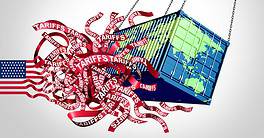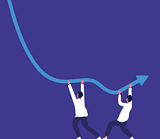North Africa is emerging as a growth engine, led by Egypt and Morocco. But structural challenges persist.
This year again, North Africa is the fastest growing region in Africa and the Arab world. Combined GDP growth in Mauritania, Morocco, Algeria, Tunisia, Egypt, and Libya is expected to reach 4% in 2025, compared to 3.9% for the rest of the continent and 2% in the Middle East, according to the International Monetary Fund.
They aim to keep the trend going. Despite differing economic trajectories, the six countries have signed multiple agreements over the years to boost trade. Chronic political tensions have limited the impact of these deals, and North Africa is far from being a unified market. But there is still growth potential.
In 2023, Egypt’s exports to North Africa reached a record $3.5 billion, or 9% of total exports. Trade with Morocco has nearly doubled over the past decade and Libya is Egypt’s largest regional export market, with many Egyptian companies playing a role in the war-torn country’s reconstruction.
In support of corporate activity, many of the region’s local banks have established a cross-border footprint. Attijariwafa Bank, Morocco’s leading institution, operates in Tunisia, Mauritania, and Egypt. Algerian banks have recently expanded into Mauritania and Tunisia’s Banque International Arabe de Tunisie (BIAT) which has offices in Libya.
“Many Tunisian SMEs export to Libya and vice versa, and this sector holds strong growth potential,” says Elyes Jebir, general director of BIAT, Tunisia’s largest bank by assets.
For now, Europe is still the main trading partner for North African countries, but Morocco and Egypt are also increasingly looking south of the Sahara for new ventures.
“Our added value is supplying safe and effective products at an affordable price,” says Seif Yashar Helmy, director of international affairs at Pharco Pharmaceuticals, which ships 20% of its exports—worth $9 million a year—to other parts of Africa and expects strong growth in the coming years thanks to a new line of World Health Organization-approved mRNA vaccine.
Egypt And Morocco Lead The Way
Egypt is by far North Africa’s largest market with a population of over 110 million, half of whom are under 30. The country is emerging from a severe fiscal crisis that almost led to bankruptcy in 2024, but is expected to post a solid 3.8% GDP growth this year, according to the IMF. While the economy relies heavily on foreign support and imports, Cairo, Africa’s largest city, has a strong industrial base across sectors including textiles, food processing, and automotive.
Pharco, Egypt’s leading pharmaceutical maker, produces 1.7 million boxes of drugs a day. During last year’s crisis, it had to scale back some production, but optimism is returning.
“We see the economy picking up, and prospects are good,” says Helmy. Pharco recently invested $350,000 in Medoc, a clinic management startup. “Egypt is underserved in healthcare, be it clinics, polyclinics, laboratories, imagery, and that opens opportunities.”
Recent reforms, including the floating of the Egyptian pound, have helped stabilize the economy and rekindled foreign investors’ interest. Many local companies are seeking new global partners, and a robust pipeline of IPOs is expected on the Egyptian Stock Exchange.
“The laws are becoming more flexible for foreigners to invest, and we see a lot of appetite for foreign direct investment [FDI] coming from Europe and the Gulf Cooperation Council,” Helmy notes.
Egypt also boasts some of Africa’s largest banks and most successful financial innovators. Fawry and MNT Halan were among the region’s first fintechs to reach $1 billion valuations. Today, Cairo is one of Africa’s top three fintech hubs, home to hundreds of startups from giants like Paymob to emerging players such as Sahl and Kilivvr.
For fintech entrepreneurs, structural challenges, from low financial literacy to currency devaluation, are creating space for innovation.

“There’s a universal problem in our region, which is a lack of foreign currency, combined with rising inflation, shooting consumer price indices, and no investment products,” says Ahmed Amer, CEO of Web3 tech provider EMURGO Labs. “People basically only have two ways of investing their money, either in gold or in real estate.” EMURGO has supported the launch of USDA, a stablecoin regulated by the US Securities and Exchange Commission that is pegged to the US dollar for trade finance and remittances.
“It’s really important that emerging economies start thinking outside of the box to develop new ways of attracting and preserving capital,” Amer adds.
Traditional banks are moving in the same direction. “We’re investing heavily in building a group-wide data infrastructure, not only in Egypt but across our African footprint,” says Islam Zekry, group CFO and COO at Commercial International Bank (Egypt), the country’s largest private bank. “One clear opportunity lies in streamlining KYC and compliance processes. By creating an integrated data warehouse and sharing verified customer intelligence across our markets, we expect to reduce the cost to serve by 20% to 30%. We aspire to be a platform that attracts capital, connects businesses, and delivers a new standard of banking experiences, all while being proudly rooted in Egypt.”
Morocco is the second pillar of North Africa’s economy. Decades of economic reforms encouraging private sector growth and infrastructure investment have turned the country into an FDI magnet. Today, Morocco is considered one of the best places in Africa to do business, with global giants including Procter & Gamble, Unilever, Siemens, and AstraZeneca setting up factories and regional headquarters in the kingdom. Despite global headwinds, the IMF expects Morocco’s GDP to grow 3.9% this year.
Tunisia Faces Headwings
Other North African countries present a different story.
Mauritania, Algeria, and Libya remain largely shut off, rent-driven economies. In Tunisia, despite years of deep economic and financial turmoil, the government still has not enacted reforms that could unlock IMF support.
Last year, the Central Bank of Tunisia had to step in to bail out the economy, and the IMF projects growth for 2025 at just 1.4%. That said, the banking sector has held up relatively well. In March, Moody’s upgraded Tunisia’s sovereign debt rating to Caa1 from Caa2, citing the central bank’s ability to maintain stable foreign exchange reserves.
“Results for 2023, 2024, and the first half of 2025 demonstrate the resilience of Tunisian banks,” argues BIAT’s Jebir. “I believe we can expect progress in Tunisia’s next reviews, which would have a positive knock-on effect for banks’ ratings. This would enable us to expand further internationally without being constrained.”
Tunisia’s banking model is still largely brick-and-mortar, but modernization efforts are underway. This year, the government passed laws restricting the use of paper checks and encouraging digital payments. Jebir sees an opportunity in the shift.
“We are developing a wide range of digital solutions for both retail and corporate clients,” he says. “At the same time, we are reshaping our branch network into advisory and expertise centers, providing added value beyond the traditional services of a bank.”
A fintech ecosystem is emerging, with startups such as mobile wallet Floucy, but international investors remain cautious.
“It’s tough to operate there,” says Amer, who has supported Tunisian startups in the past. “I mean, it’s very hard to attract FDI when your fiscal and monetary policy doesn’t provide any confidence to the investors, right?”
Looking South
As their own economies improve, North African companies are looking south for expansion, supported by their banks. Moroccan lenders now operate across the continent; Bank of Africa, Attijariwafa, and BCP Group cover more than 25 African countries, from Senegal to Ethiopia. Egyptian banks, including CIB and Banque Misr, are following trade corridors in East Africa using Kenya as a regional base.
“We’re enhancing SME lending through digital partnerships, leveraging the country’s well-developed ecosystem,” says CIB’s Zekry. “We’re also advancing digital channels to scale access and deepen client engagement, reflecting our broader model of localized innovation with regional consistency.”
Zekry also sees growth potential in climate finance. “As we expand across Africa, a significant share of our growth will come from transitional finance, particularly in agricultural and underserved communities. We’re introducing specialized services in these areas, not just as a development goal but because they make strong business sense.”
Cross-border trade, industrial strength, and financial innovation are opening new opportunities throughout North Africa, but structural issues remain. “The potential is massive, but reforms need to continue and the capacity to introduce new technologies will be critical,” Amer observes. If these elements align, North Africa could realize its aspiration to become a strategic hub connecting Europe, the Middle East, and sub-Saharan Africa.




